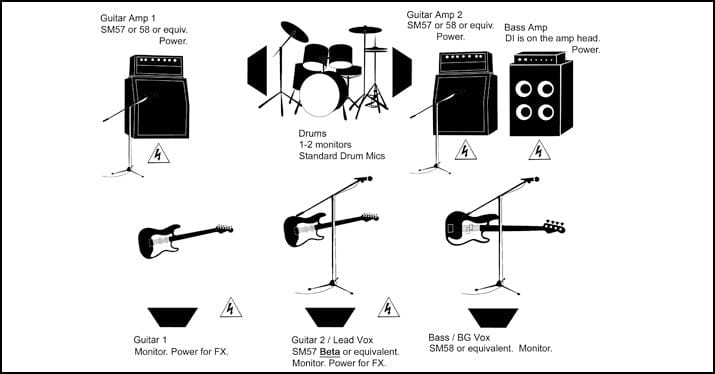A well-made stage plot goes hand in hand with a successful live show. Not only does it keep your band organized, but it also ensures you have good communication with your venues prior to your shows. To help you prepare for the stage, we’re covering what stage plots are, where and when to use them, how to create them and more.
What is a Stage Plot?
A stage plot is a diagram that dictates how your band will be set up on stage during a live performance. It's also known as a band stage plot, a stage plan or a band stage diagram. Generally, a stage plot contains information like the position of each band member and everyone’s main gear.
Often the stage plot is crafted together with the input list, which shows all the inputs along with the channels they're patched into. This information helps the venue, festival, promoter or sound engineer know what to expect so they know how to best set up in advance of the show.
What Should Be on a Stage Plot?
Stage plots can be basic or detailed, but it's generally a good idea to make them as specific as possible. Think of it like creating a map or diagram - the more direction you offer, the easier it’ll be to set everything up. This is especially important if you have a non-standard stage setup.
Because there's so much information that can be included in a stage plot, it can be tricky to decide what goes and what stays. After all, you definitely don’t want a cluttered map that's difficult to decipher. There are a few essential things to keep in mind if you’re wondering how to make a stage plot for a band. Using these tips will help ensure your stage plot stays on track:
- Band name and contact details
- Position and names of each member and the instruments they use
- Preferred location of mics, DIs, monitors, power, amps, etc.
- Whether bass and keyboard amplifiers will be mic’d or run direct
- How much sound gear you'll need the venue to provide, and what you'll provide
- Notes about general monitor mixes
- Any other pertinent info, depending on the particular setup
What is an Input List?
As we noted earlier, a stage plot is often accompanied by an input list, so you might also want to know how input lists work. In simplest terms, an input list just provides details about any connections you’ll need on stage to perform well. For example, you could create an input list that includes anything from snake channel and DI preference, to mic stand preference and location of the input on stage.
Like a stage plot, an input list gives the venue and sound tech the information they need to help set you up for success with the best sound when you finally hit the stage.
How to Create a Stage Plot
Now that you understand how a stage plot works, the next step is figuring out how to make a stage plot for a band. If you’re looking to go the simpler and easier route, all you really have to do is jot down your stage plot on a piece of paper, take a picture and then send it over to the relevant people. It may not be neat or artistic, but as long as it's clear and accurate, it’ll do the job.
If you can't create a formal stage plot on your own, at the very least you want to create an input list or a list of everyone who’ll be on stage and any gear they'll be connected to.
If you’re looking for an even easier route that still makes you look like a pro, you can find plenty of stage plot software, apps and word processing programs that help you quickly create a stage plot. Regardless of how you create your stage plot, the following steps will help get you started:
- Use circles to represent the drum kit
- Use circles with an X inside to denote microphones
- Make your amplifiers rectangular
- Make your stage wedges triangles
- Draw or doodle things like keyboards, guitars or basses (or simply label them)
Stage Plot Examples
Having some visual examples can help you quickly figure out a stage plot structure that’s best for your setup. For this, you can check out the images below, but keep in mind there's no one-size-fits-all stage plot. Stick to the basics where necessary, or customize as you enhance your setup.

Conclusion
A stage plot is really just a simple diagram that can make a big statement when it comes to showing you're ready to perform in the big leagues. The information here helps ensure you'll shine on stage ahead of any gig, live performance or show.
Ready to take your band to the next level with a professional, well-crafted stage plot? Affordable online tools like Tecrider.com or Stage Plan are convenient and get the job done, so check them out before your next gig.
Looking for gear for your band? Seismic Audio has everything you need to get on the stage or in the studio. Check out our wide selection of amps and mixers, PA speaker systems, mics and stands, cables and more. We’ve got you covered when it comes to jamming like a pro.

 ">
">
 ">
">
